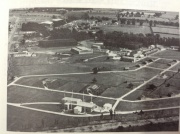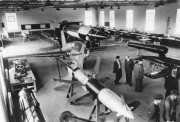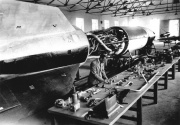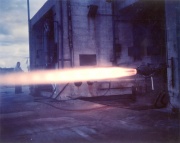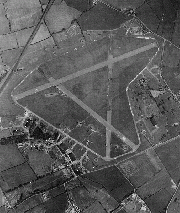Rocket Propulsion Establishment
From The Space Library
The Guided Projectile Establishment opened at Westcott in April 1946 and was used as an internment site for captured German rocket scientists until 1948.
The site was chosen because it had good road access and was on the RAF base. The first chief superintendent was W.R. Cook, his subordinates were F. Elstub, an RAF rocket expert, and A.D. Baxter a propulsion expert from Farnborough. Cook would retire in October 1947 and be replaced by Air Commodore Charles Leslie Dann.
Gathering of some of the rocket scientists at Westcott, summer 1947, l to r, W. Schoenheit, Unknown, D.P. Maddock, Unknown, Ruth Skinner, A. Horne, Alice, D. L. Lidster, C.G. Saunt, G. Fiedler, R.A. Carter, W. Kretschmer, H. Reichhart, J. Frauenberger Courtesy Ed Andrews Collection
In late 1946 Dr Johannes Schmidt was in charge of 12 internee German rocket scientists at Westcott. Other Germans voluntarily employed at Westcott in 1946-47 included: Herman Treutler (physicist), Friedrich Jessen (engineer), Heinrich Walder (engineer), Jurgen Diedrichsen (chemist), Gustav Fiedler (designer, draftsman) Johannes Frauenberger (design draftsman), Karl Meier (engineer), and Walter Koltermann (foreman fitter).
Later the group increased to a total of 16 and included one of the earliest rocket pioneers, Walter Riedel. Almost all of the Germans came from the Walterwerke in Kiel Germany and as a consequence of that were mostly familiar with high test hydrogen peroxide rocket engines. Several of them seem to have been recruited from the Saenger Institute immediately after the war, including Schmidt and Riedel. Almost all of the Germans stayed in the UK for the remainder of their lives.
The Guided Projectile Establishment was renamed the Rocket Propulsion Department, part of the Royal Aircraft Establishment (RAE) in the late 1940s. In the mid 1950s work was undertaken to develop a large sounding rocket named Skylark. In the late 1950s the liquid propellant motor for the Blue Streak missile (the RZ2) was developed at Westcott and went on to be used in the Europa-1 space rocket launch vehicle.
Rockets such as Blowpipe, Seawolf, Blue Steel, Polaris and Chevaline were undertaken at the facility.
In 1977 Westcott and the Waltham Abbey research station were merged to form the Propellants, Explosives and Rocket Motor Establishment.
